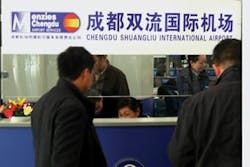From Sweet to Sour
Just five years ago, British-based Menzies Aviation signed a 10-year contract with the Chengdu Airport Authority (CAA) forming a joint venture for passengers, cargo and aircraft handling, line maintenance and ground support.
“We were in the right place at the right time,” says Chris Hutchinson, Menzies general manager at that time.
Parallel with the growth of the Chinese economy, and a healthy aviation climate, the venture got off to a flying start.
Late 2008 the word around the terminals was that Menzies wanted to pull out and was looking for a company to take over the remainder of the tenure.
In early 2009 Simon Yiend, managing director of Menzies Macau, states (in reference to Chengdu), “Altogether is has not been a satisfactory experience. Talks are in progress with the CAA for handover of some control.” The Board Chairman of the CAA, Pan Xiao Jun declined to be interviewed, saying that “it was too sensitive.” Menzies management in Chengdu avoided any meeting to discuss this matter.
Menzies first entered the Chinese marketplace in 2000 through the acquisition of Ogden Aviation in Hong Kong and Macau, giving them a strong presence in the two Special Administrative Regions. The company then sought for further expansion into the mainland proper, and decided on a second tier airport.
Settling for Chengdu, Hutchinson says, “We had several reasons: the ‘go west policy’ of the central government, the tax breaks and incentives and finally the Airport Authority which struck us as being the progressive and innovative. A good partner is essential as there is no opportunity for a wholly foreign-owned enterprise in this industry.”
Investment into the enterprise involved $2 million (giving a 40 percent stakeholding) providing for a 10-year tenure, with an option for a further five years. Subsequently, the JV spent another quarter million on Chinese-made ramp equipment.
Hutchinson went on to say, “The first three months was spent getting to know the three separate businesses that were part of the joint venture: passenger and cargo, aircraft line maintenance and ground service maintenance. All had separate managements, finance and administration departments. My aim was to blend them together under one management team, and at the same time to restructure the new company into a more flexible and efficient company.”
As he delved deeper into the business, Hutchinson uncovered other aspects that were not to his liking. “Through painful experience, we learnt that due diligence, both financial and legal need to be 100 percent on the ball.”
Chengdu, with a population of some five million, is the capital of Sichuan, the home province of the giant panda, and gateway to all of western China. It is a major hub city with air, rail and highways spreading in all directions, and a natural transit point to major tourist attractions at Xi’an, Leshan and Lhasa.
Manufacturing in the city has a diverse spread of products. Intel, the chip giant has its largest Asian plant here and was given the red carpet treatment by the city council upon their start up in 2004. Pharmaceuticals, the hi-tech industry, boot and shoe factories are major employers. Rudders for the Boeing 787 Dreamliner are made here and shipped to Seattle.
The airport, named Shuangliu International, ranks at sixth place in all of China for passengers and cargo. In 2004 passenger traffic stood at 11.5 million and cargo at 0.21 million tons. The figures jumped to 18.5 million with cargo at 0.35 million in just four years.
Sixteen carriers fly from or into the airport serving 89 domestic destinations. Regional and international airlines fly to seven neighboring Asian countries. The only direct intercontinental flight is a nonstop tri-weekly service with a KLM B777 to Amsterdam. The airport has but one runway, and flight numbers are restricted to 500 per day, with operating hours from 6:00 a.m. through to 2:00 a.m.
The joint venture presently handles eight local carriers and five non-domestic. Their competitor in ground handling is another consortium, which includes the national carrier Air China. Chengdu-based Sichuan Airlines attend to their own fleet of 40 aircraft.
The western influence from Menzies brought about an unusual effect to other aviation companies at the airport. Hu Guanqiang, cargo manager at Sichuan Airlines, says, “All our staff are now coming to work in uniform, before that they wore their own ordinary clothes. It seems that we want to copy their professional style.”
The earthquake in May 2008, which shattered towns and villages only 100 miles away, was a supreme test of the venture’s management ability. Swinging immediately into a 24/7 operation, the partnership handled more than 80 freighters with aid and relief cargoes, and in one memorable day the inward tonnage handled exceeded 4000 tons, far above their daily average of 200.
Full cargo aircraft are not a usual sight at Shangliu. Adrian Davies, director of the UK Department of International Development, commented after seeing the unloading of thousands of tents out of Emirates 747s from Dubai and Karachi, “My impression was of a very competent and effective organization.”
Now the biting economic squeeze is on worldwide. Aviation ground handling companies in central China are not exempt from this turbulent struggle to survive.
Due to the increase in value of the yuan, export-orientated factories are laying off staff, and one freight terminal reports a drop in domestic traffic of more than 30 percent.
KLM Cargo Manager Joe Ji goes higher with a 40-percent drop on all Europe-bound cargo.
Local and international passenger figures given out by the CAA have slid down by 13 percent in the second half of 2008.
Grouped together with the earthquake, falling export cargo and the global financial meltdown, the aviation business in Sichuan has lost its spice and flavor.
